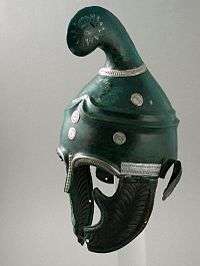Phrygian helmet
The Phrygian helmet, also known as the Thracian helmet,[2] was a type of helmet that originated in Classical Greece and was widely used[3] in Thrace, Dacia, Magna Graecia and the Hellenistic world until well into the Roman Empire.


Characteristics
The names given to this type of helmet are derived from its shape, in particular the high and forward inclined apex, in which it resembles the caps (usually of leather) habitually worn by Phrygian and Thracian peoples. Like other types of Greek helmet, the vast majority of Phrygian helmets were made of bronze. The skull of the helmet was usually raised from a single sheet of bronze, though the forward-pointing apex was sometimes made separately and riveted to the skull. The skull was often drawn out into a peak at the front, this shaded the wearer's eyes and offered protection to the upper part of the face from downward blows. The face was further protected by large cheekpieces, made separately from the skullpiece. Sometimes these cheekpieces were so large that they met in the centre leaving a gap for the nose and eyes. When constructed in this manner they would have embossed and engraved decoration to mimic a beard and moustache.[4]
Use

The Phrygian helmet was worn by Macedonian cavalry in King Philip's day but his son Alexander is said to have preferred the open-faced Boeotian helmet for his cavalry, as recommended by Xenophon.[5] The royal burial in the Vergina Tomb contained a helmet which was a variation on the Phrygian type, exceptionally made of iron, this would support its use by cavalry. The Phrygian helmet is prominently worn in representations of the infantry of Alexander the Great's army, such on the contemporary Alexander sarcophagus.[6] The Phrygian helmet was in prominent use at the end of the Classical Era and into the Hellenistic period, replacing the earlier 'Corinthian' type from the 5th century BC.[note 1][7]
Notes
- The naming conventions and typology of ancient helmets are largely of modern origin and do not reflect contemporary usage; Connolly, P. (1981) Greece and Rome at War. Macdonald Phoebus, London. ISBN 1-85367-303-X, p. 60: "Terms such as 'Illyrian' and 'Attic' are used in archaeology for convenience to denote a particular type of helmet and do not imply its origin."
References
- Burns, Mike (2011). Mougins Museum of Classical Art. M. Merrony. p. 221, fig. 112.
- Rome's Enemies (1): Germanics and Dacians (Men at Arms Series, 129) by Peter Wilcox and Gerry Embleton,1982,page 20,"... people, as were the Phrygians and those Thracians living north ... the solid crest of a 'Phrygian'-type helmet as a running pattern, as shown on the pedestal reliefs; ..."
- The Army of Alexander the Great (Men at Arms Series, 148) by Nicholas Sekunda and Angus McBride,1992,page 6,"... Philip gave them heavy armour-cuirasses and helmets of the `Phrygian' type-and he further developed the new tactical formations of Jason of Pherai ..."
- Connelly, pp 70-71
- Anderson, J.K, (1961) Ancient Greek Horsemanship, Berkeley and Los Angeles. pp. 147- 148.
- Heckel, W. and Jones, R. (2006) Macedonian Warrior Alexander's elite infantryman, Osprey, p 61, ISBN 978-1-84176-950-9,2006
- Connoliy, p. 63
Bibliography
- Anderson, J.K, (1961) Ancient Greek Horsemanship, Berkeley and Los Angeles.
- Connolly, P. (1981) Greece and Rome at War. Macdonald Phoebus, London. ISBN 1-85367-303-X
| Wikimedia Commons has media related to Phrygian helmets. |